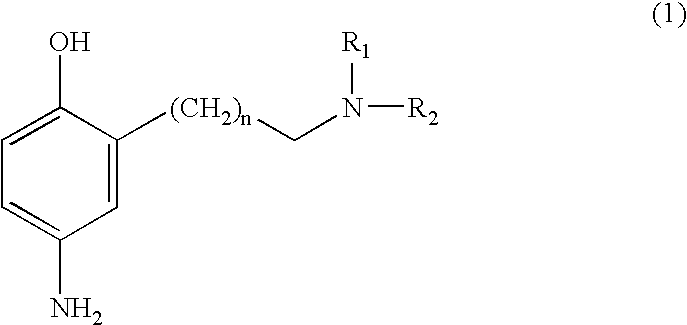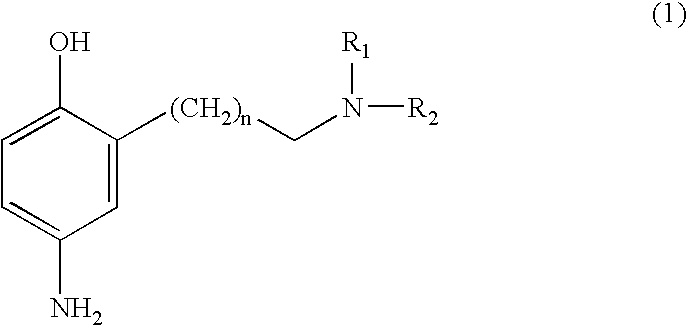Primary intermediates for oxidative coloration of hair
a technology of oxidative coloration and intermediates, which is applied in the direction of hair cosmetics, dyeing process, organic chemistry, etc., can solve the problems of p-aminophenol use being questioned, and the proposed replacement of p-aminophenol not being entirely satisfactory
- Summary
- Abstract
- Description
- Claims
- Application Information
AI Technical Summary
Benefits of technology
Problems solved by technology
Method used
Image
Examples
example 1
Dyeing Example 1
[0079] The following composition shown in Table 1 can be used for dyeing Piedmont hair. 100 g of the dyeing composition is mixed with 100 g 20 volume hydrogen peroxide. The resulting mixture is applied to the hair and permitted to remain in contact with the hair for 30 minutes. The dyed hair is then shampooed, rinsed with water and dried. The ranges of ingredients set out in Table 1 are illustrative of useful concentrations of the recited materials in a hair dye product.
1TABLE 1 Composition for Dyeing Hair Ingredients Range (wt %) Weight (%) Cocamidopropyl betaine 0-25 17.00 Polyquaternium-22 0-7 5.00 Monoethanolamine.sup.1 0-15 2.00 Oleic Acid 2-22 0.75 Citric Acid 0-3 0.10 28% Ammonium hydroxide.sup.1 0-15 5.00 Behentrimonium chloride 1-5 0.50 Sodium sulfite 0-1 0.10 EDTA 0-1 0.10 Erythorbic acid 0-1 0.40 Ethoxydiglycol 1-10 3.50 C11-15 Pareth-9 (Tergitol 15-S-9) 0.5-5 1.00 C12-15 Pareth-3 (Neodol 25-3) 0.25-5 0.50 Isopropanol 2-10 4.00 Propylene glycol 1-12 2.00 p...
PUM
| Property | Measurement | Unit |
|---|---|---|
| Digital information | aaaaa | aaaaa |
Abstract
Description
Claims
Application Information
 Login to View More
Login to View More - R&D
- Intellectual Property
- Life Sciences
- Materials
- Tech Scout
- Unparalleled Data Quality
- Higher Quality Content
- 60% Fewer Hallucinations
Browse by: Latest US Patents, China's latest patents, Technical Efficacy Thesaurus, Application Domain, Technology Topic, Popular Technical Reports.
© 2025 PatSnap. All rights reserved.Legal|Privacy policy|Modern Slavery Act Transparency Statement|Sitemap|About US| Contact US: help@patsnap.com



